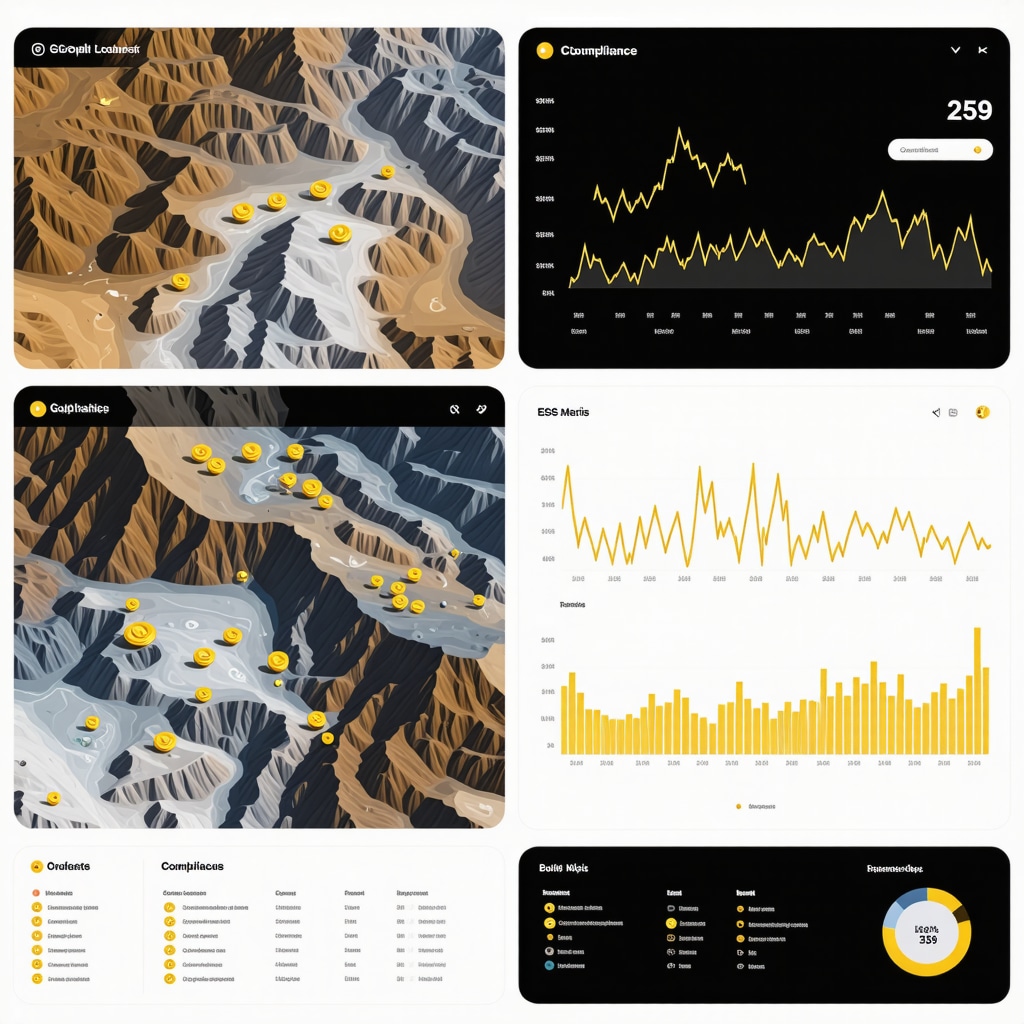Decoding the Complex Dynamics of Gold Demand in the Modern Market
Gold remains an enduring asset that reflects multifaceted economic signals and investor sentiments worldwide. Understanding gold demand trends requires a nuanced grasp of its diverse drivers, from jewelry consumption and technological applications to central bank acquisitions and investment flows. For the discerning buyer, these trends offer critical insights to navigate market volatility and optimize acquisition timing.
Interplay Between Jewelry Demand and Industrial Use: Unveiling Hidden Market Pressures
Jewelry manufacturing continues to dominate gold consumption globally, accounting for a significant percentage of annual demand. However, variations in cultural preferences, economic cycles, and disposable income levels create complex fluctuations in this sector. Simultaneously, industrial demand—spanning electronics, medical devices, and aerospace—adds a steady baseline that can buffer or amplify price changes. An insightful analysis must consider these intertwined sectors to anticipate shifts in gold prices effectively.
How Do Central Bank Gold Purchases Influence Global Demand and Pricing?
Central bank policies profoundly impact gold markets, particularly when these institutions engage in aggressive purchasing to diversify reserves and hedge against currency risks. Recent trends show emerging economies increasing their gold holdings, thereby tightening supply and elevating prices. This phenomenon has been extensively studied in specialized market analyses, revealing how central bank behavior can serve as a leading indicator for market movements.
Investment Demand Dynamics: ETFs, Bullion, and Mining Stocks as Market Sentinels
Investor appetite for gold manifests through diverse channels, including exchange-traded funds (ETFs), physical bullion, and mining equities. Each avenue exhibits distinct responsiveness to macroeconomic variables such as inflation expectations, geopolitical tensions, and currency fluctuations. Profound expertise is essential to evaluate which vehicle aligns best with an investor’s risk tolerance and strategic goals, especially given the evolving landscape documented in recent investor-focused trend reports.
Market Supply Constraints: How Mining Output and Recycling Impact Demand Equilibrium
Supply-side factors, including declining ore grades, geopolitical risks in mining regions, and environmental regulations, constrain gold availability. Conversely, recycling of scrap gold acts as a variable returning supply to the market, influenced by price incentives and economic conditions. Comprehensive understanding of these forces is essential for predicting supply-demand imbalances that affect price volatility.
Strategic Considerations for Smart Buyers in a Shifting Gold Market
Incorporating these layered demand drivers, smart buyers must adopt a multifactorial approach, balancing physical acquisition strategies with market timing and diversification. Engaging with authoritative resources such as secure purchasing guides enhances transactional safety and investment integrity.
What Emerging Trends in Gold Demand Should Buyers Monitor to Stay Ahead?
Current discourse among financial experts highlights the growing influence of digital gold platforms, ESG-compliant mining practices, and shifting demographic preferences in major consuming countries. Staying abreast of these developments through trusted channels supports proactive investment decisions and portfolio resilience.
For a deeper dive into these sophisticated market dynamics, explore our expert articles on what drives gold market prices in 2025 and advanced gold trading techniques.
According to the World Gold Council, analyzing demand segments in tandem with macroeconomic indicators provides unparalleled foresight into price trajectories and investor opportunities.
Technological Innovations Shaping Gold Demand Beyond Traditional Sectors
While jewelry and industrial applications remain pivotal, emerging technologies are triggering new demand vectors for gold. Innovations such as quantum computing and advanced electronics increasingly rely on gold’s superior conductive and corrosion-resistant properties. Moreover, the integration of gold nanoparticles in biomedical uses expands its industrial footprint, subtly altering demand profiles. Investors and buyers must recognize these nuanced shifts, as they signal a gradual but persistent rise in gold’s strategic value beyond conventional consumption.
Could Emerging Technologies Redefine Gold’s Role in the Global Economy?
Exploring this question requires a multidisciplinary perspective. The expanding role of gold in cutting-edge fields like nanotechnology and renewable energy storage suggests that demand could diversify significantly over the next decade. This diversification may contribute to stabilizing gold prices amid economic uncertainties, providing a hedge not only against inflation but also technological disruption. Such trends are highlighted by recent studies from the World Gold Council, which emphasize technology-driven demand growth as a key market influencer.
Risk Management in Gold Investments: Navigating Volatility and Regulatory Landscapes
Investors must also grapple with volatility stemming from geopolitical tensions, fluctuating monetary policies, and environmental regulations affecting mining operations. Strategic risk mitigation involves diversifying across physical assets, ETFs, and mining stocks, each carrying distinct risk-return profiles. Understanding regulatory environments, especially those enforcing ESG criteria, is increasingly critical. This complexity underscores the importance of resources like advanced trading techniques that enable savvy navigation of market turbulence.
Evaluating Gold Mining Stocks: A Specialist’s Guide to Capitalizing on Market Movements
Mining equities offer leveraged exposure to gold price movements but require careful analysis of company fundamentals, geopolitical risks, and operational efficiency. Key indicators include ore grade quality, production costs, and sustainable mining practices, which increasingly influence investor sentiment and stock valuations. For those interested in this facet of gold investment, our detailed advice on top gold mining stocks to watch in 2025 provides actionable insights.
Investors keen to deepen their understanding of these advanced dimensions of gold demand and supply dynamics are encouraged to explore the comprehensive guides and analyses available at BuyingOldNow.
Engage with this article by sharing your perspectives in the comments below or sharing it with fellow investors to foster a community well-versed in gold market intricacies.
Unearthing the Impact of Geopolitical Shifts on Gold Demand: Beyond Traditional Paradigms
In a world increasingly defined by geopolitical uncertainty, gold’s role as a safe haven asset is more pronounced than ever. However, the relationship between geopolitical events and gold demand transcends simple cause-and-effect paradigms. Sophisticated market participants recognize that nuanced geopolitical developments—such as trade wars, regional conflicts, and shifts in diplomatic alliances—catalyze complex responses across different gold demand segments. For instance, while retail investors might flock to physical bullion during crises, institutional actors could recalibrate their gold-backed derivatives or ETF positions, affecting liquidity and price dynamics in distinct ways. The interplay between these multifaceted responses demands a granular, data-driven approach to anticipate market movements with precision.
How Do Emerging Geo-Economic Alliances Reshape Global Gold Consumption Patterns?
Recent years have seen the rise of strategic alliances that influence currency stability and reserve management policies. Nations within such alliances often coordinate to bolster gold reserves, leveraging collective purchasing power to influence global supply. This phenomenon, documented by the International Monetary Fund’s 2023 working paper, underlines how macroeconomic cooperation can subtly yet significantly alter gold market equilibria. Consequently, discerning investors must integrate geopolitical risk assessments alongside traditional economic indicators to gauge demand trajectories accurately.
Innovative Financial Instruments and Their Role in Gold Demand Amplification
Beyond physical gold and conventional ETFs, the financial ecosystem has birthed increasingly sophisticated instruments that influence demand. Structured products, gold-backed digital tokens, and algorithm-driven investment funds introduce new dynamics into market liquidity and accessibility. These instruments often appeal to tech-savvy, younger demographics, expanding gold’s reach and demand base. Understanding the regulatory frameworks governing these assets, as well as their correlation with traditional gold investments, is essential for advanced portfolio diversification strategies.
What Are the Risks and Rewards Associated with Gold-Backed Digital Assets in Modern Portfolios?
Gold-backed digital assets, while promising enhanced liquidity and fractional ownership, pose unique challenges such as counterparty risk, technological vulnerabilities, and regulatory uncertainty. Balancing these factors requires a nuanced risk management approach supported by continuous market monitoring and expert guidance, as detailed in SEC’s comprehensive analysis on crypto-assets and gold. For seasoned investors, integrating these instruments judiciously can optimize returns while maintaining exposure to gold’s intrinsic value.
Environmental, Social, and Governance (ESG) Criteria: A Paradigm Shift Affecting Gold Supply and Demand
The escalating emphasis on ESG compliance is reshaping gold mining operations and investor preferences alike. Mining companies are increasingly evaluated based on sustainable practices, community engagement, and transparency, influencing capital inflows and stock valuations. On the demand side, ESG-conscious investors are driving preference towards responsibly sourced gold, prompting innovations in traceability and certification technologies. This shift not only impacts supply chain dynamics but also introduces new layers of complexity in assessing gold’s true market value and long-term demand sustainability.
Industry leaders and investors aiming to stay at the forefront of these transformative trends should explore our specialized coverage on ESG integration in gold markets, available at BuyingGoldNow’s ESG Gold Insights.
Decoding Seasonal and Cyclical Patterns in Gold Demand: Leveraging Data Analytics for Strategic Advantage
Seasonal festivities, cultural buying habits, and cyclical economic trends introduce predictable yet often underappreciated fluctuations in gold demand. Advanced data analytics and machine learning models now empower investors and traders to identify subtle patterns and anomalies, facilitating more refined timing strategies. For example, South Asian wedding seasons traditionally boost jewelry demand, while fiscal year-end portfolio adjustments can influence ETF flows. Incorporating such seasonality with broader macroeconomic variables enriches forecasting models and enhances decision-making precision.
Charting the Future: Integrating Multidimensional Data Streams for Holistic Gold Market Forecasting
As the gold market becomes increasingly complex, integrating diverse data streams—from satellite imagery of mining activity and social media sentiment analysis to macroeconomic indicators and geopolitical risk scores—offers unprecedented forecasting capabilities. Leveraging artificial intelligence and big data analytics can uncover latent demand drivers and emerging risks, empowering investors and policymakers alike. This multidimensional approach represents the frontier of gold market expertise, blending quantitative rigor with qualitative insights to navigate an ever-evolving landscape.
Harnessing AI and Big Data: Revolutionizing Gold Demand Forecasting
In the contemporary gold market, traditional analysis is increasingly augmented by the integration of artificial intelligence and big data methodologies. These sophisticated tools enable investors to dissect vast, heterogeneous datasets—ranging from satellite-based monitoring of mining operations to real-time social media sentiment analysis—thereby uncovering subtle demand signals and latent market drivers previously undetectable through conventional means. Such multidimensional data fusion facilitates predictive modeling with enhanced granularity, allowing for anticipatory positioning ahead of market shifts.
For instance, leveraging machine learning algorithms to analyze macroeconomic indicators alongside geopolitical risk indices can identify correlations that influence gold demand fluctuations with unprecedented accuracy. This approach empowers market participants to transcend reactive strategies, embracing proactive investment frameworks rooted in quantitative rigor and qualitative nuance.
How Can Integrating Satellite Imagery and Social Sentiment Analytics Enhance Gold Market Predictions?
Satellite imagery provides objective, near-real-time insights into mining output levels and supply chain disruptions, while social sentiment analytics capture investor mood and consumer confidence trends impacting demand segments such as bullion buying and jewelry consumption. When integrated, these datasets enable a comprehensive view of supply-demand dynamics, facilitating dynamic risk assessment and strategic decision-making. The Nature Scientific Reports on remote sensing applications in mining exemplifies how such technologies can refine resource estimation and market forecasting.
Quantum Computing and Its Emerging Role in Gold Market Dynamics
Quantum computing, although nascent, presents transformative potential for solving complex optimization problems inherent in portfolio management and price forecasting within the gold market. By simulating multifactorial interactions at speeds unattainable by classical computers, quantum algorithms could soon enable investors to model scenario analyses with profound depth, accounting for variables such as fluctuating monetary policies, ESG compliance trajectories, and geopolitical developments concurrently.
Decoding the Impact of ESG-Driven Supply Chain Innovations on Gold Pricing
Environmental, Social, and Governance (ESG) imperatives are catalyzing supply chain innovations that enhance traceability and ethical sourcing in the gold industry. Blockchain implementations for provenance verification and advances in low-impact mining technologies are reshaping cost structures and market perceptions. This evolving landscape affects both supply constraints and demand preferences, as ESG-compliant gold increasingly commands premium valuation among institutional investors prioritizing sustainability.

Strategic Portfolio Diversification: Incorporating Digital Gold Tokens and Algorithmic Trading
The proliferation of gold-backed digital tokens and algorithm-driven investment funds introduces novel liquidity channels and democratizes access to gold ownership. These instruments, while offering lower entry barriers and enhanced fractionalization, necessitate sophisticated risk management frameworks to mitigate technological vulnerabilities and regulatory uncertainties. Seasoned investors must balance traditional physical holdings with these innovative vehicles to optimize portfolio resilience in a digitized financial ecosystem.
What Are the Advanced Risk Mitigation Techniques for Gold-Backed Digital Asset Investments?
Effective risk mitigation involves continuous due diligence on issuer credibility, smart contract audits, and adherence to evolving regulatory standards. Employing diversified holdings across multiple platforms and integrating real-time monitoring tools can further reduce exposure to systemic failures. The U.S. Securities and Exchange Commission’s comprehensive report provides an authoritative framework for navigating this complex asset class.
Engage With Our Expert Analysis and Elevate Your Gold Market Strategy
For investors and analysts aspiring to master the intricate fabric of gold demand dynamics, embracing these advanced analytical paradigms and emerging technologies is indispensable. We invite you to delve deeper into our specialized resources at BuyingGoldNow, fostering a community of informed decision-makers adept at capitalizing on the evolving gold market landscape.
Expert Insights & Advanced Considerations
Integrating Multidimensional Data Enhances Predictive Accuracy
Advanced investors recognize that leveraging diverse data sources—from satellite imagery tracking mining activity to real-time social media sentiment analysis—provides a more holistic understanding of gold demand fluctuations. This fusion of quantitative and qualitative data enables anticipatory strategies that outperform traditional reactive approaches, as elaborated in global gold demand analyses.
ESG Compliance is Reshaping Both Supply and Investor Preferences
Environmental, Social, and Governance criteria now play a pivotal role in gold market dynamics. Mining operations prioritizing sustainable practices attract premium valuations, while responsible sourcing influences demand patterns among institutional investors. Staying informed on ESG-driven innovations, such as blockchain for provenance verification, is essential for effective market participation, as discussed in ESG Gold Insights.
Digital Gold Tokens and Algorithmic Trading Open New Investment Frontiers
The emergence of gold-backed digital assets and algorithm-driven funds democratizes access but introduces unique risks including regulatory uncertainty and technological vulnerabilities. Expert risk mitigation involves rigorous due diligence and portfolio diversification across traditional and digital holdings, highlighted in advanced trading techniques.
Central Bank Purchases Signal Strategic Shifts Impacting Market Equilibria
Central banks’ increasing gold acquisitions, especially by emerging economies, effectively tighten supply and elevate prices. This macroeconomic behavior serves as a leading indicator for broader market trends, necessitating close monitoring for informed investment decisions. Detailed exploration is available in central bank gold purchase analyses.
Curated Expert Resources
- World Gold Council Research Hub: Comprehensive, data-driven insights on global gold demand and supply trends, invaluable for macro-level market understanding.
- BuyingGoldNow’s Advanced Trading Guides: Practical frameworks and methodologies for navigating gold market volatility and optimizing portfolio strategies.
- International Monetary Fund Working Papers: Authoritative analyses on geopolitical and economic influences shaping gold demand at the sovereign level.
- U.S. Securities and Exchange Commission Reports: Critical evaluations on gold-backed digital assets and regulatory considerations for innovative investment vehicles.
- Nature Scientific Reports on Remote Sensing and Mining: Cutting-edge research on technological applications enhancing resource estimation and market forecasting.
Final Expert Perspective
The evolving landscape of gold demand is shaped by an intricate interplay of traditional consumption patterns, technological innovation, ESG imperatives, and geopolitical developments. A nuanced understanding of these multifaceted drivers, augmented by integration of advanced data analytics and emerging financial instruments, positions investors to anticipate market shifts with greater precision. By engaging deeply with authoritative resources and embracing a multidimensional analytical approach, stakeholders can navigate the complexities of gold demand confidently and strategically.
We encourage readers to further enrich their expertise by exploring specialized guides such as the Step-by-Step Guide to Buying Gold Bullion Bars Safely and to share their professional insights to foster a community of well-informed gold market participants.










